THE AUDIO NOTE P1 SE
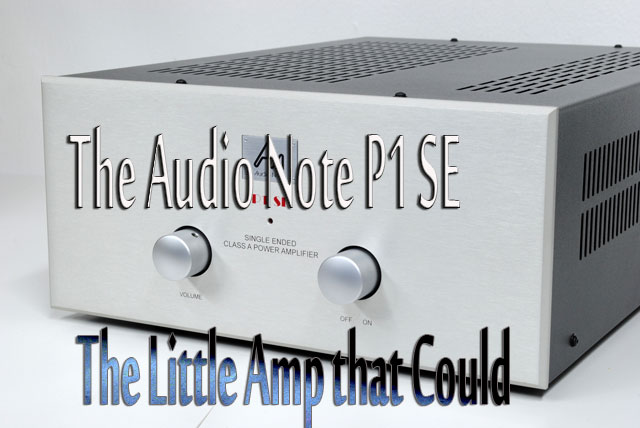
My first introduction to single-ended tubed amplifiers came via the auspices of an Audio Note Kit One using a pair of 300B tubes. It was, at that time (which was 1995 to be precise) my first audiophile amplifier, not counting a Rotel 965BX which was all I could afford on my pupil’s salary[1]. To me, the Audio Note Kit One was a dream come true and I cherished every moment I spent with it. In 1995, not many American audiophiles would have heard of a single-ended directly-heated 300B amplifier, the virtues of which were rediscovered in the late 80s by discerning Japanese audiophiles such as Jean Hiraga (okay, he was also part French). Most Americans would have scoffed at and dismissed the 300B tube as a toy or a quaint relic of a bygone era, not to be taken seriously. The widespread use of power hungry speakers at the time, such as Apogees and Avalons, would have precluded the use of these kind of flea-powered amps. UK audiophiles, on the other hand, were a little more, shall we say, spiritually in tune with their Japanese counterparts, and it took a little article written by a certain Alan Sircom for a small magazine called “Hi Fi Choice” to educate me about the virtues of this arcane technology using a forgotten valve (Brit-speak for tubes) which should really have been relegated to the pages of audio history since the 1940s. But life has a funny way of making old things new and relevant again. Thank you for your prescience Alan, wherever you are.
Skip forward to 2015, which is exactly 20 years later. Single end directly heated triode technology is so mainstream now it’s almost passe. Tell someone that you are using an 8-watt amp of whatever persuasion, and instead of shocked derision, you may get a nod of understanding and a question about the kind of speaker you are using with it. This is a good thing. I like the fact that we have choices now, and we don’t all have to fill our lives with big sand amps (not everybody kvells for Krells) and big hard-to-drive speakers. I like the fact that audiophiles as a whole are better informed, and more accepting of each other’s different preferences. Which means I don’t have to apologize nor explain too much when I tell you that the Audio Note (UK) P1 SE is definitely an amplifier that benefits from and is a product of these last 20 years’ worth of audio progress.
[1] “Pupillage”, for those who are not exposed to the British-based common law system of legal training, is the name given to the activity which a person, fresh from being called to the Bar, has to undertake before he can become a full-fledged Barrister-at-law. Hence, the person who undergoes such an activity is called a “pupil”. The word Barrister describes an individual who has been called TO the Bar, and is not to be confused with the word “Barista” which describes someone working AT the bar, usually (but not exclusively) that of Starbucks or your local watering hole.
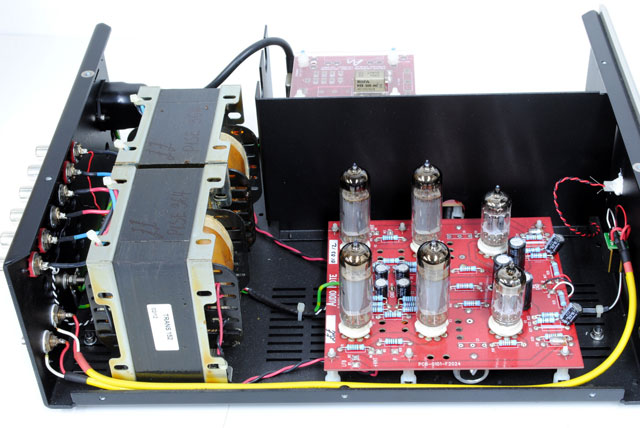
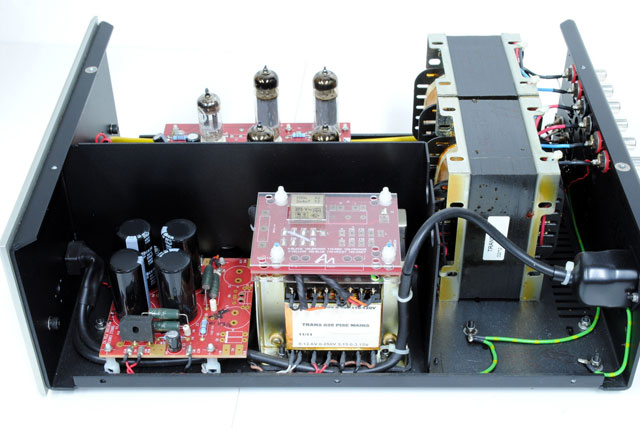
INSIDE THE P1 SE
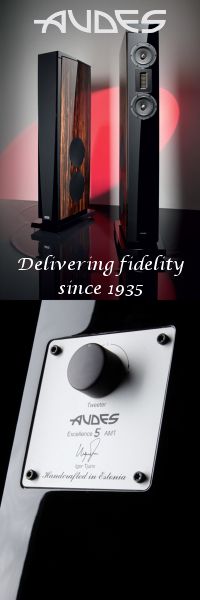 The “SE” in the nomenclature, for those who skipped the introduction, stands for Single-Ended. And just in case you happened to re-join civilization after a 20-year solo research stint in the Antarctic, a single-ended tube amplifier is one, and I quote from Wikipedia since I cannot do better, “that uses a single tube to produce an output, in contrast to a push-pull amplifier which uses a pair of devices with antiphase inputs to generate an output”. In layman’s terms, a SE amp does not break up the signal into 2 parts and then reassemble it again. Detractors complain that single-ended watts tend to be small, but as a tube-guru once said, “it’s the quality of that first watt that counts”. Like the Audio Note Kit One, the P1 SE develops a grand total of 10 watts, from a maximum consumption of 90 watts. That an efficiency of less than 12%. Class D amps, in comparison, go up to 90%. SE amps get hot, but the P1 SE not unduly so. Even then, you should not be daft enough to place it in a closed cupboard. It needs good ventilation to breathe and perform. The P1 SE does not use 300Bs, it uses a much more “mundane” output tube (four of them in parallel configuration) called the EL84. EL84s do not have the cachet or the mystique of the 300B. It is a workhorse tube used in radios and guitar amps. So the P1 SE isn’t going to win any awards for sex appeal. Apart from these headline facts, Audio Note puts this unit at Level 2 (which is 3 levels below their ultimate Level 5 products whose hallowed halls include such legends as their version of the Ongaku). Inside, you will find two more ECC83 triodes for voltage amplification, and to round up the roll call of nice but not necessarily űber expensive parts, Beyschlag metal film resistors, Audio Note branded mylar in oil signal caps, and an Audio Note 100k potentiometer to act as volume control, which means you can use as an integrated if you so wished. As I was using the P1 with my regular reference preamp (a Constellation Virgo II with the optional DC filter), I had this control at maximum setting the entire review period, and used the Virgo to attenuate volume.
The “SE” in the nomenclature, for those who skipped the introduction, stands for Single-Ended. And just in case you happened to re-join civilization after a 20-year solo research stint in the Antarctic, a single-ended tube amplifier is one, and I quote from Wikipedia since I cannot do better, “that uses a single tube to produce an output, in contrast to a push-pull amplifier which uses a pair of devices with antiphase inputs to generate an output”. In layman’s terms, a SE amp does not break up the signal into 2 parts and then reassemble it again. Detractors complain that single-ended watts tend to be small, but as a tube-guru once said, “it’s the quality of that first watt that counts”. Like the Audio Note Kit One, the P1 SE develops a grand total of 10 watts, from a maximum consumption of 90 watts. That an efficiency of less than 12%. Class D amps, in comparison, go up to 90%. SE amps get hot, but the P1 SE not unduly so. Even then, you should not be daft enough to place it in a closed cupboard. It needs good ventilation to breathe and perform. The P1 SE does not use 300Bs, it uses a much more “mundane” output tube (four of them in parallel configuration) called the EL84. EL84s do not have the cachet or the mystique of the 300B. It is a workhorse tube used in radios and guitar amps. So the P1 SE isn’t going to win any awards for sex appeal. Apart from these headline facts, Audio Note puts this unit at Level 2 (which is 3 levels below their ultimate Level 5 products whose hallowed halls include such legends as their version of the Ongaku). Inside, you will find two more ECC83 triodes for voltage amplification, and to round up the roll call of nice but not necessarily űber expensive parts, Beyschlag metal film resistors, Audio Note branded mylar in oil signal caps, and an Audio Note 100k potentiometer to act as volume control, which means you can use as an integrated if you so wished. As I was using the P1 with my regular reference preamp (a Constellation Virgo II with the optional DC filter), I had this control at maximum setting the entire review period, and used the Virgo to attenuate volume.
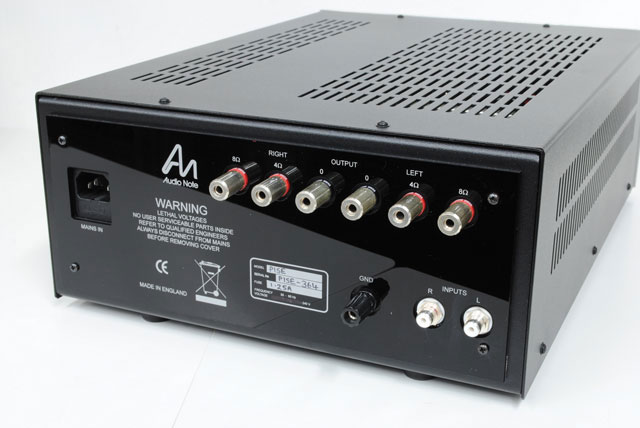
Behind, you will not find any surprises. It has a single pair of RCA inputs (no XLR, sorry). Speaker terminals give you the choice of 4 or 8 Ohm taps. And that’s it, really. Simplicity that befits a single-ended product. The only other thing I would mention is that, unlike the pictures shown above, the version I got for review had a silver faceplate. I very much preferred that look than this black and gold one, but with amplifiers as with women, we all have our preferences.
SOUND QUALITY
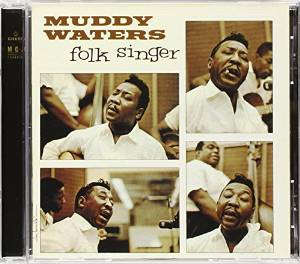 One of the first CDs I used for serious evaluation of the P1 SE was Muddy Water’s “Folk Singer.” Having lost both my original MOFI CD and LP in a messy divorce, I had some years ago replaced these with a German pressing (HDRCD10001 remastered by Volker Bohlmeier). The P1 SE threw a deep soundstage with plenty of ambience and air around Waters’ voice (which I have no doubt is recorded with a reverb plate), but seemed to lack the intimacy of the MOFI LP I used to listen to with the 300B based AN Kit One, playing Lowther PM6As. Guitars sounded steely and not as rounded or as rich as the LP. Of course, I am not playing fair. I am comparing digital with vinyl and a cheap Shanling CD player with a Koetsu cartridge and Shindo-ed Garrard 401. But, the P1 SE gets quite a ways there, despite the disadvantages. I was impressed. There was hardly any distortion when Waters shouts and pins the meters to the right. In this respect, they behave much better than the same 10 watts from the 300Bs.
One of the first CDs I used for serious evaluation of the P1 SE was Muddy Water’s “Folk Singer.” Having lost both my original MOFI CD and LP in a messy divorce, I had some years ago replaced these with a German pressing (HDRCD10001 remastered by Volker Bohlmeier). The P1 SE threw a deep soundstage with plenty of ambience and air around Waters’ voice (which I have no doubt is recorded with a reverb plate), but seemed to lack the intimacy of the MOFI LP I used to listen to with the 300B based AN Kit One, playing Lowther PM6As. Guitars sounded steely and not as rounded or as rich as the LP. Of course, I am not playing fair. I am comparing digital with vinyl and a cheap Shanling CD player with a Koetsu cartridge and Shindo-ed Garrard 401. But, the P1 SE gets quite a ways there, despite the disadvantages. I was impressed. There was hardly any distortion when Waters shouts and pins the meters to the right. In this respect, they behave much better than the same 10 watts from the 300Bs.
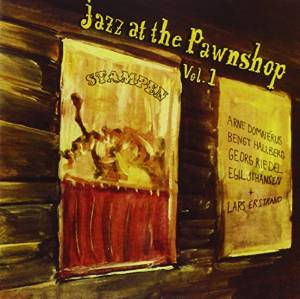 Same results were observed with a “Jazz In The Pawnshop” SACD. This recording showed that the P1 SE had a better boogey factor than the Kit One, and was better controlled in the bass without getting boomy or muddy. In fact, compared with my present reference monoblocks using massive GU-80 transmission tubes, which boast 270 single-ended watts in bridge-tied load configuration, the P1 SE actually sounds deeper than the reference amps! Go figure. The P1 SE also sounds fast and agile, definitely not your father’s single-ended amp with its typically slow, overly warm and tubby mien. It is modern and not afraid to be in your face when the occasion calls for it.
Same results were observed with a “Jazz In The Pawnshop” SACD. This recording showed that the P1 SE had a better boogey factor than the Kit One, and was better controlled in the bass without getting boomy or muddy. In fact, compared with my present reference monoblocks using massive GU-80 transmission tubes, which boast 270 single-ended watts in bridge-tied load configuration, the P1 SE actually sounds deeper than the reference amps! Go figure. The P1 SE also sounds fast and agile, definitely not your father’s single-ended amp with its typically slow, overly warm and tubby mien. It is modern and not afraid to be in your face when the occasion calls for it.
Take for example, large orchestral works such as Scene of the Drunken Poet from Purcell’s “The Fairy Queen” (edited by Britten and Imogen Holst), performed by the English Symphony Orchestra and Aldeburgh Festival Singers. The P1 SE’s measly 10 watts had no problems carrying the big climactic moments (“Drive him hence away, away”) whatsoever, while at the same time keeping the singers in the choir distinct rather than melding them into one homogeneous wall of voice. This humorous piece needs appropriate verve and pizzazz from the system to sound right, and the P1 SE delivered. This piece was probably just within its capabilities, and that’s enough.
How does the P1 SE soundstage? Well, as mentioned above, it goes deep, but the images stay resolutely between the speakers. They are unable to go as wide as my reference amps do. But this is more than made up for in the way it brings out the depth information in recordings. This trait, allied with more than creditable lows, can make for very thrilling listening. In Dadawa (Zhu Zequn’s) “Sister Drum” CD (Feidie Records 4509-99592-2), the P1 SE recreates the synthesized drum hits that signal the Dadawa’s entry to the chorus of Sister Drum, where she sings the Buddhist mantra “om manipadme om” in an almost cathartic cri de coeur. Sure, the P1 SE does not slam you in the chest and flap your trouser legs in the way that 1kW solid statersdo, but it will sweep you away with the emotional and spiritual overtones of the song better than many muscle amps can. Here is the answer to those unbelievers who complain that small single-ended cannot do bass.
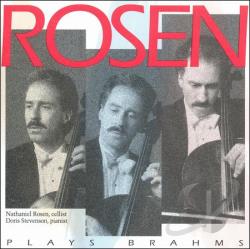 The mids of the P1 SE remind me of the 300B magic. John Marks’ CD of Nathaniel Rosen and Doris Stevenson playing Brahms (JMR 5) has a reticent top and bottom end, but a glorious midrange that serves the cello and piano extremely well. The P1 SE eats up this kind of simply-miked, intimately recorded albums for breakfast. It is just the kind of diet that this amp loves. The P1 SE had enough resolving power to allow me to hear the rapid intakes of Rosen’s breath, and Stevenson’s pedal points.The cello is reproduced enough detail and insight that I did not miss my references too much. If you are into chamber music or spare arrangements of breathy female vocalists, you will be put in a very nice place by this amplifier. That’s saying a lot for a little amp that costs less than a quarter of what my reference monoblocks cost when they were still being sold.
The mids of the P1 SE remind me of the 300B magic. John Marks’ CD of Nathaniel Rosen and Doris Stevenson playing Brahms (JMR 5) has a reticent top and bottom end, but a glorious midrange that serves the cello and piano extremely well. The P1 SE eats up this kind of simply-miked, intimately recorded albums for breakfast. It is just the kind of diet that this amp loves. The P1 SE had enough resolving power to allow me to hear the rapid intakes of Rosen’s breath, and Stevenson’s pedal points.The cello is reproduced enough detail and insight that I did not miss my references too much. If you are into chamber music or spare arrangements of breathy female vocalists, you will be put in a very nice place by this amplifier. That’s saying a lot for a little amp that costs less than a quarter of what my reference monoblocks cost when they were still being sold.
Is it perfect? No, of course it isn’t. Which amplifier is? The P1 SE, much as it exhibits a fair amount of the single-ended magic, is never going to sound like its more distinguished (and much more costly) brethren such as the Jinro or (God forbid) the Ongaku. As I mentioned, it does not have very a wide, wall-demolishing soundstage, although what is between the speakers is well rounded and fleshed out. Images also tend to be laid back compared with my reference, and sometimes can sound like a discombobulated wallflower-like blob in the middle, unable or unwilling to open up. This meant that no matter how I turned up the Virgo II’s volume, I could never get it to have that lit-from-within sound of my references. I don’t know if I am hearing the limitations of the 10 watts, perhaps I am; after all, 10 watts is 10 watts, and it is what it is.
But – and this is the crux of the whole matter – for the 10 watts that it does muster, the P1 SE makes full use of what it has and develops enough single-ended magic to shame any equivalently priced transistor amp. If you truly value and prize this kind of rich, fleshed out and timbrally realistic sound, then I would submit that amplifiers like this one will satisfy you for a long time to come, and at a very competitive price indeed.
CONCLUSION
Frankly, I did not have very high expectations of the P1 SE. I was expecting it to be warm, fuzzy and “nice” to listen to, but not really a serious audiophile tool to enjoy and bring new insight into your music. I was surprised by its resolution, clarity and power (within reason), all served up with a generous dollop of that elusive single-ended beauty. Don’t get your knickers in a twist about not having 300Bs, for once you hear what it can do, you will find that it matters very little in the final analysis. Together with its keenly priced stablemates the P1 PP (push pull version), the P2 SE and P2 PP, it’s the sort of amplifier that I wish was available 20 years ago, when esoteric hard-to-find kits with exotic expensive tubes were the only answer to my impecunious musical dreams. Now, you do have that kind of choice and at a price point that everyone can afford. Exercise it wisely.

stephen Yan
Specifications:
Price: $2895.00
10 watt parallel single-ended Class A stereo amplifier,
Tube: 4 x EL84, 4 x ECC83,
Beyschlag metal film resistors,
Audio Note™ tin foil/mylar in oil signal capacitors, standard electrolytic capacitors,
Audio Note™ 100K input volume control allows use as a standalone one input control centre
Stereo Times Masthead
Publisher/Founder
Clement Perry
Editor
Dave Thomas
Senior Editors
Frank Alles, Mike Girardi, Russell Lichter, Terry London, Moreno Mitchell, Paul Szabady, Bill Wells, Mike Wright, and Stephen Yan,
Current Contributors
David Abramson, Tim Barrall, Dave Allison, Ron Cook, Lewis Dardick, John Hoffman, Dan Secula, Don Shaulis, Greg Simmons, Eric Teh, Greg Voth, Richard Willie, Ed Van Winkle, Rob Dockery, Richard Doran, and Daveed Turek
Site Management Clement Perry
Ad Designer: Martin Perry






Be the first to comment on: THE AUDIO NOTE P1 SE